Procedia-Social and Behavioral Sciences docx.
VerifiedAdded on 2022/08/20
|10
|2474
|17
AI Summary
Contribute Materials
Your contribution can guide someone’s learning journey. Share your
documents today.
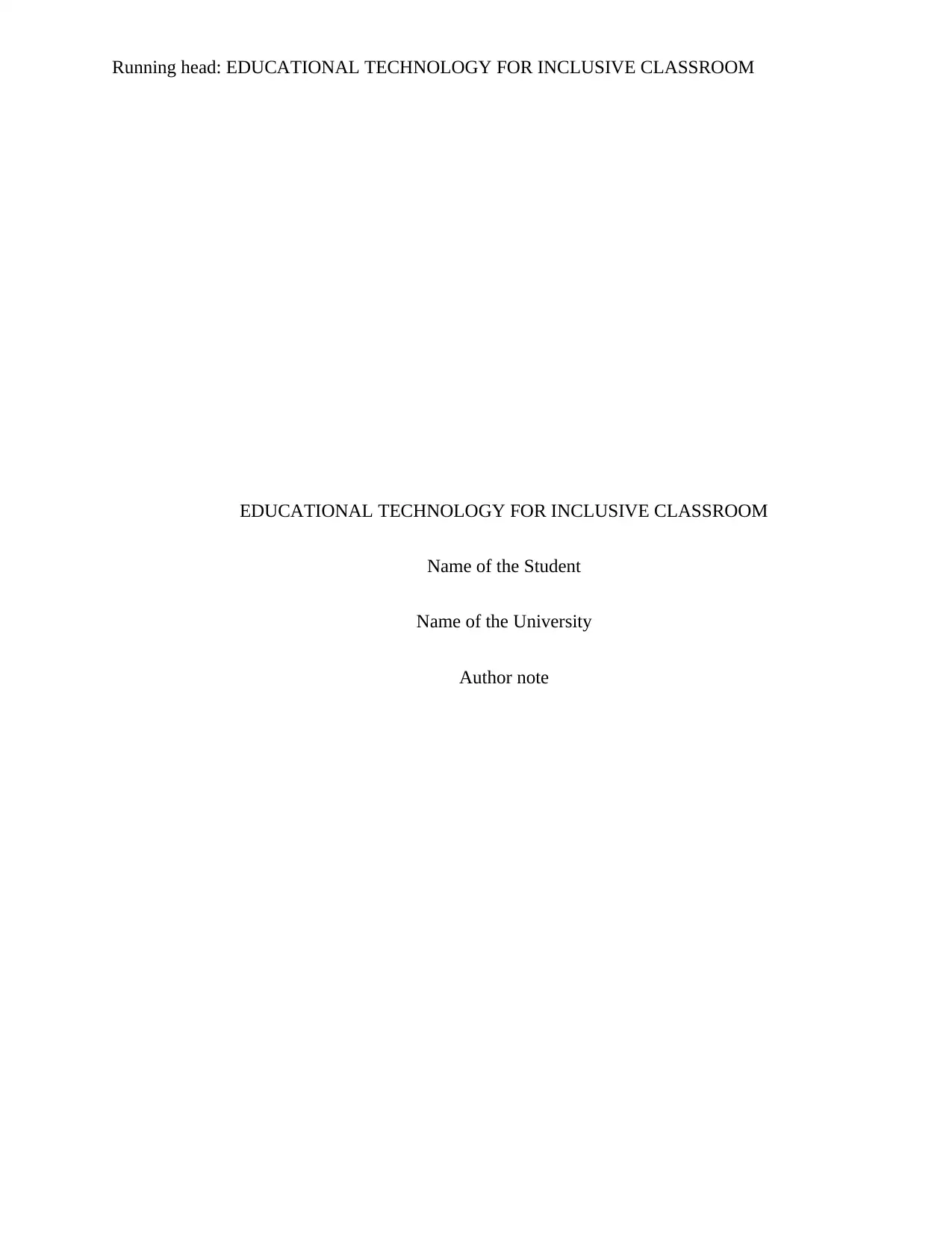
Running head: EDUCATIONAL TECHNOLOGY FOR INCLUSIVE CLASSROOM
EDUCATIONAL TECHNOLOGY FOR INCLUSIVE CLASSROOM
Name of the Student
Name of the University
Author note
EDUCATIONAL TECHNOLOGY FOR INCLUSIVE CLASSROOM
Name of the Student
Name of the University
Author note
Secure Best Marks with AI Grader
Need help grading? Try our AI Grader for instant feedback on your assignments.
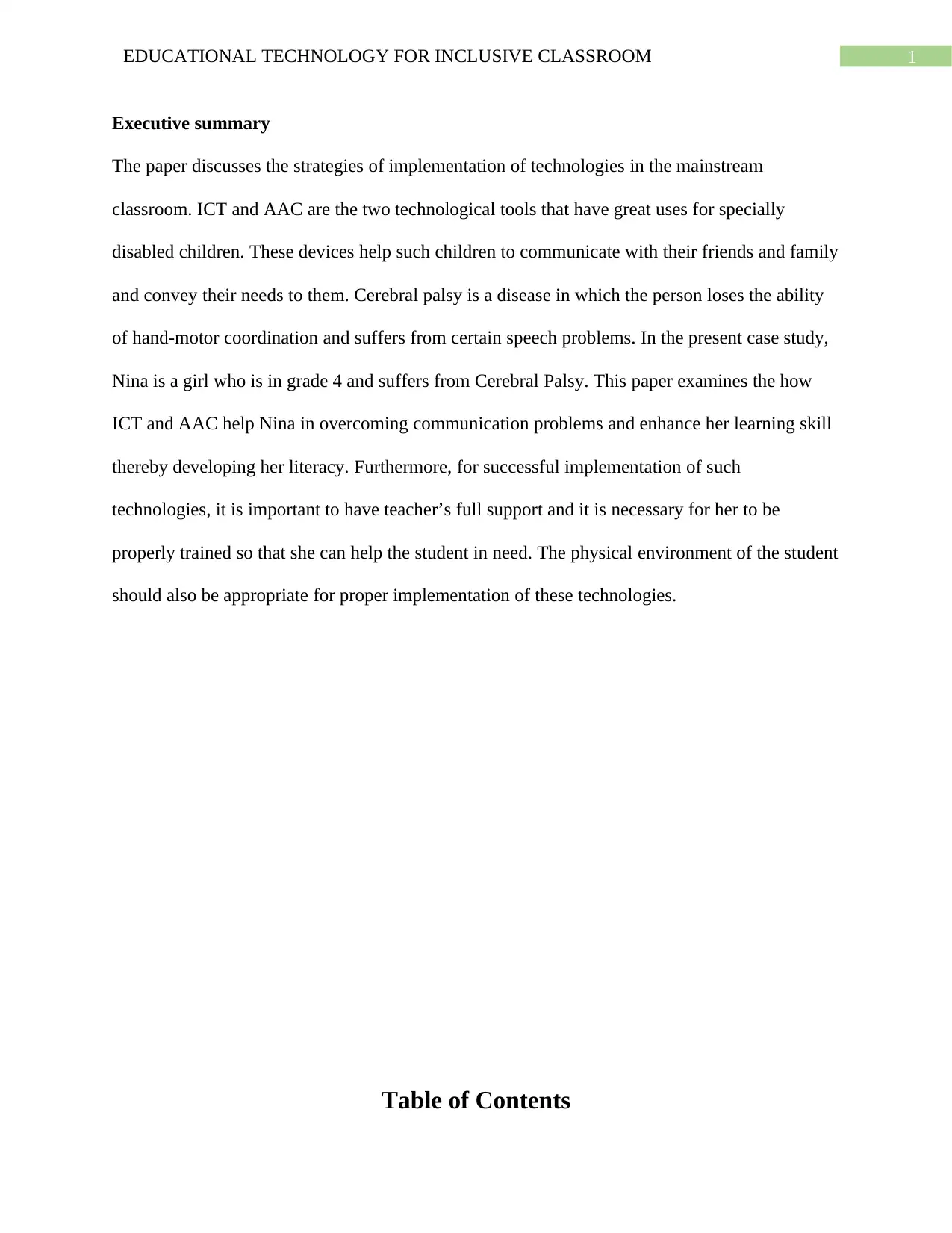
1EDUCATIONAL TECHNOLOGY FOR INCLUSIVE CLASSROOM
Executive summary
The paper discusses the strategies of implementation of technologies in the mainstream
classroom. ICT and AAC are the two technological tools that have great uses for specially
disabled children. These devices help such children to communicate with their friends and family
and convey their needs to them. Cerebral palsy is a disease in which the person loses the ability
of hand-motor coordination and suffers from certain speech problems. In the present case study,
Nina is a girl who is in grade 4 and suffers from Cerebral Palsy. This paper examines the how
ICT and AAC help Nina in overcoming communication problems and enhance her learning skill
thereby developing her literacy. Furthermore, for successful implementation of such
technologies, it is important to have teacher’s full support and it is necessary for her to be
properly trained so that she can help the student in need. The physical environment of the student
should also be appropriate for proper implementation of these technologies.
Table of Contents
Executive summary
The paper discusses the strategies of implementation of technologies in the mainstream
classroom. ICT and AAC are the two technological tools that have great uses for specially
disabled children. These devices help such children to communicate with their friends and family
and convey their needs to them. Cerebral palsy is a disease in which the person loses the ability
of hand-motor coordination and suffers from certain speech problems. In the present case study,
Nina is a girl who is in grade 4 and suffers from Cerebral Palsy. This paper examines the how
ICT and AAC help Nina in overcoming communication problems and enhance her learning skill
thereby developing her literacy. Furthermore, for successful implementation of such
technologies, it is important to have teacher’s full support and it is necessary for her to be
properly trained so that she can help the student in need. The physical environment of the student
should also be appropriate for proper implementation of these technologies.
Table of Contents
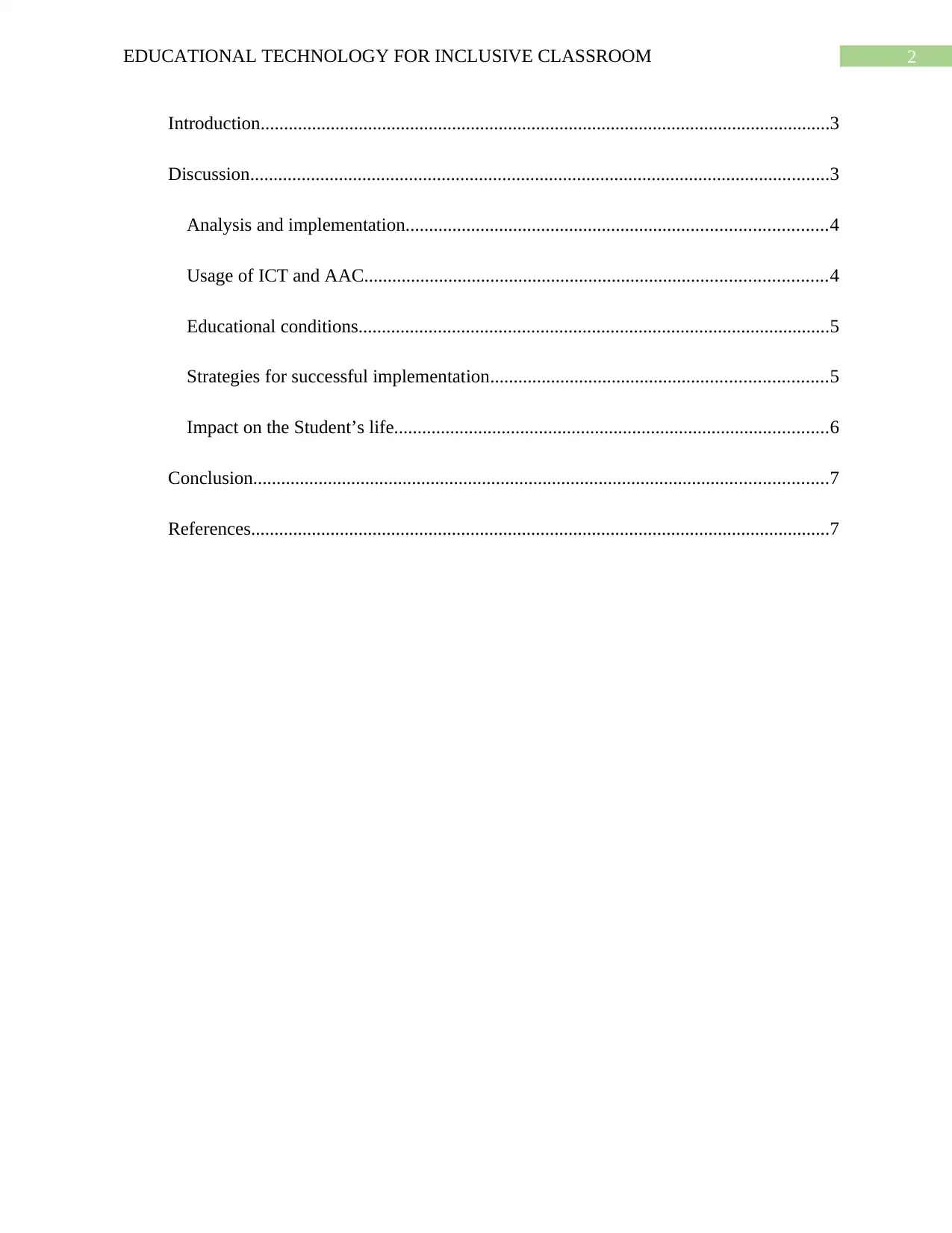
2EDUCATIONAL TECHNOLOGY FOR INCLUSIVE CLASSROOM
Introduction..........................................................................................................................3
Discussion............................................................................................................................3
Analysis and implementation..........................................................................................4
Usage of ICT and AAC...................................................................................................4
Educational conditions.....................................................................................................5
Strategies for successful implementation........................................................................5
Impact on the Student’s life.............................................................................................6
Conclusion...........................................................................................................................7
References............................................................................................................................7
Introduction..........................................................................................................................3
Discussion............................................................................................................................3
Analysis and implementation..........................................................................................4
Usage of ICT and AAC...................................................................................................4
Educational conditions.....................................................................................................5
Strategies for successful implementation........................................................................5
Impact on the Student’s life.............................................................................................6
Conclusion...........................................................................................................................7
References............................................................................................................................7
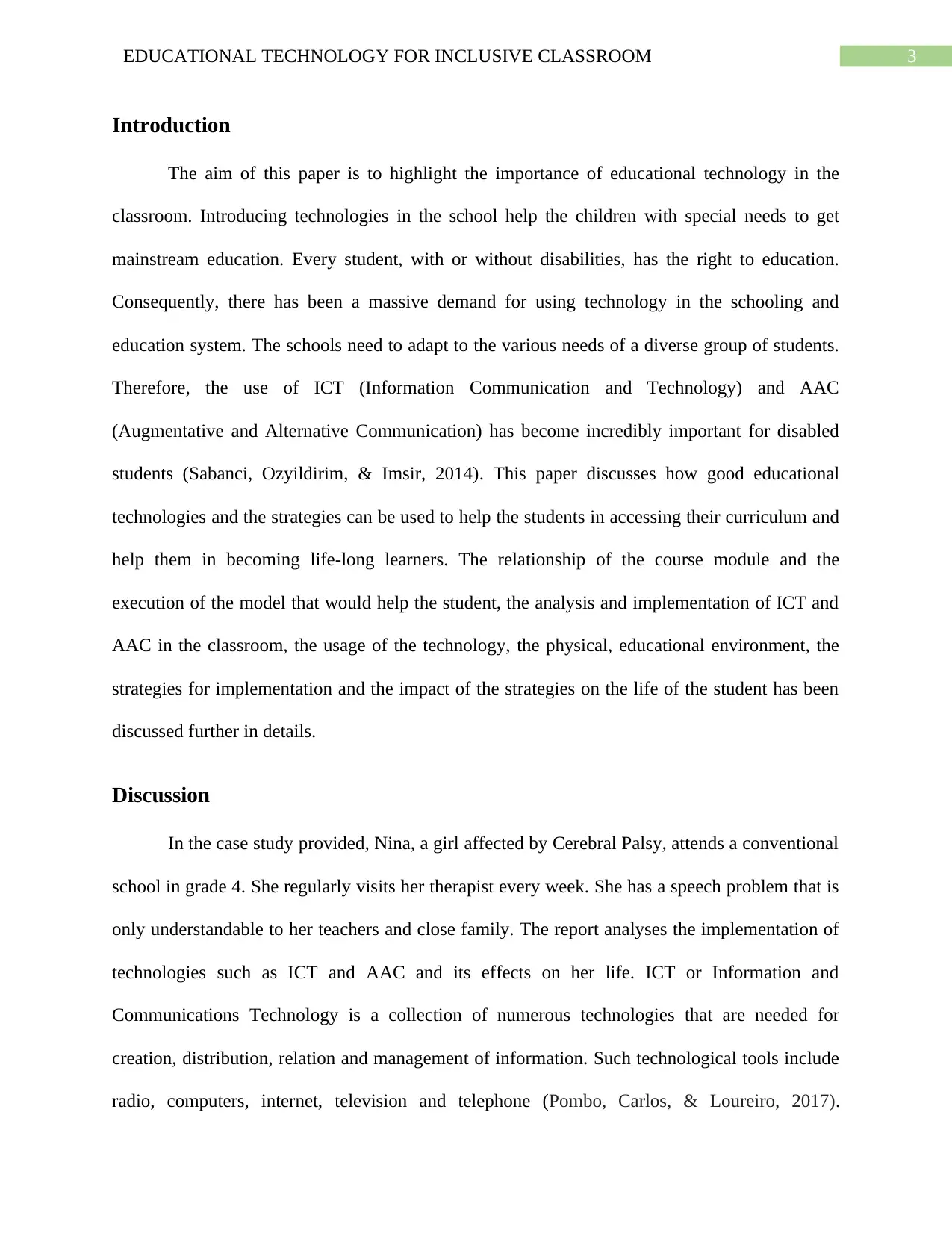
3EDUCATIONAL TECHNOLOGY FOR INCLUSIVE CLASSROOM
Introduction
The aim of this paper is to highlight the importance of educational technology in the
classroom. Introducing technologies in the school help the children with special needs to get
mainstream education. Every student, with or without disabilities, has the right to education.
Consequently, there has been a massive demand for using technology in the schooling and
education system. The schools need to adapt to the various needs of a diverse group of students.
Therefore, the use of ICT (Information Communication and Technology) and AAC
(Augmentative and Alternative Communication) has become incredibly important for disabled
students (Sabanci, Ozyildirim, & Imsir, 2014). This paper discusses how good educational
technologies and the strategies can be used to help the students in accessing their curriculum and
help them in becoming life-long learners. The relationship of the course module and the
execution of the model that would help the student, the analysis and implementation of ICT and
AAC in the classroom, the usage of the technology, the physical, educational environment, the
strategies for implementation and the impact of the strategies on the life of the student has been
discussed further in details.
Discussion
In the case study provided, Nina, a girl affected by Cerebral Palsy, attends a conventional
school in grade 4. She regularly visits her therapist every week. She has a speech problem that is
only understandable to her teachers and close family. The report analyses the implementation of
technologies such as ICT and AAC and its effects on her life. ICT or Information and
Communications Technology is a collection of numerous technologies that are needed for
creation, distribution, relation and management of information. Such technological tools include
radio, computers, internet, television and telephone (Pombo, Carlos, & Loureiro, 2017).
Introduction
The aim of this paper is to highlight the importance of educational technology in the
classroom. Introducing technologies in the school help the children with special needs to get
mainstream education. Every student, with or without disabilities, has the right to education.
Consequently, there has been a massive demand for using technology in the schooling and
education system. The schools need to adapt to the various needs of a diverse group of students.
Therefore, the use of ICT (Information Communication and Technology) and AAC
(Augmentative and Alternative Communication) has become incredibly important for disabled
students (Sabanci, Ozyildirim, & Imsir, 2014). This paper discusses how good educational
technologies and the strategies can be used to help the students in accessing their curriculum and
help them in becoming life-long learners. The relationship of the course module and the
execution of the model that would help the student, the analysis and implementation of ICT and
AAC in the classroom, the usage of the technology, the physical, educational environment, the
strategies for implementation and the impact of the strategies on the life of the student has been
discussed further in details.
Discussion
In the case study provided, Nina, a girl affected by Cerebral Palsy, attends a conventional
school in grade 4. She regularly visits her therapist every week. She has a speech problem that is
only understandable to her teachers and close family. The report analyses the implementation of
technologies such as ICT and AAC and its effects on her life. ICT or Information and
Communications Technology is a collection of numerous technologies that are needed for
creation, distribution, relation and management of information. Such technological tools include
radio, computers, internet, television and telephone (Pombo, Carlos, & Loureiro, 2017).
Secure Best Marks with AI Grader
Need help grading? Try our AI Grader for instant feedback on your assignments.
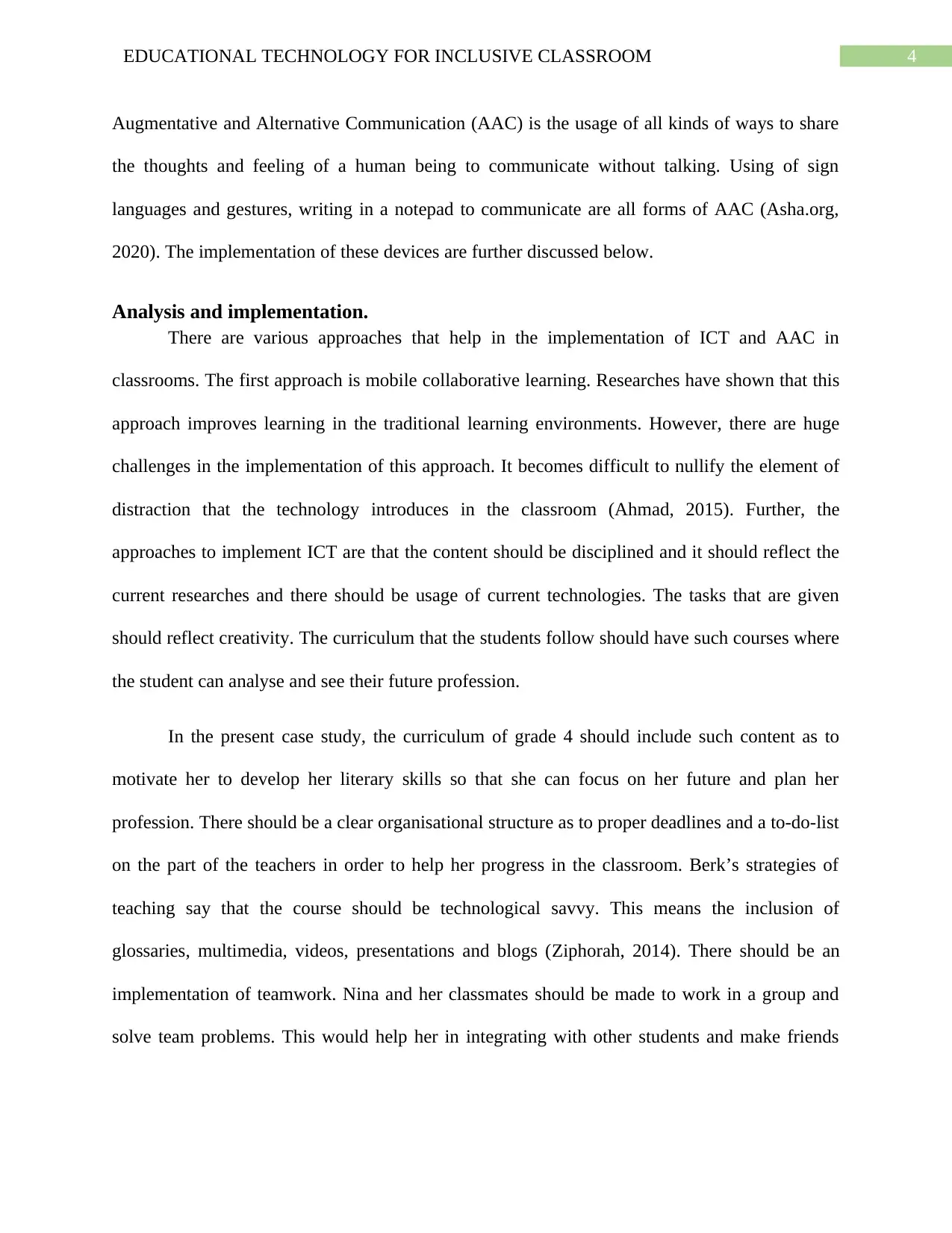
4EDUCATIONAL TECHNOLOGY FOR INCLUSIVE CLASSROOM
Augmentative and Alternative Communication (AAC) is the usage of all kinds of ways to share
the thoughts and feeling of a human being to communicate without talking. Using of sign
languages and gestures, writing in a notepad to communicate are all forms of AAC (Asha.org,
2020). The implementation of these devices are further discussed below.
Analysis and implementation.
There are various approaches that help in the implementation of ICT and AAC in
classrooms. The first approach is mobile collaborative learning. Researches have shown that this
approach improves learning in the traditional learning environments. However, there are huge
challenges in the implementation of this approach. It becomes difficult to nullify the element of
distraction that the technology introduces in the classroom (Ahmad, 2015). Further, the
approaches to implement ICT are that the content should be disciplined and it should reflect the
current researches and there should be usage of current technologies. The tasks that are given
should reflect creativity. The curriculum that the students follow should have such courses where
the student can analyse and see their future profession.
In the present case study, the curriculum of grade 4 should include such content as to
motivate her to develop her literary skills so that she can focus on her future and plan her
profession. There should be a clear organisational structure as to proper deadlines and a to-do-list
on the part of the teachers in order to help her progress in the classroom. Berk’s strategies of
teaching say that the course should be technological savvy. This means the inclusion of
glossaries, multimedia, videos, presentations and blogs (Ziphorah, 2014). There should be an
implementation of teamwork. Nina and her classmates should be made to work in a group and
solve team problems. This would help her in integrating with other students and make friends
Augmentative and Alternative Communication (AAC) is the usage of all kinds of ways to share
the thoughts and feeling of a human being to communicate without talking. Using of sign
languages and gestures, writing in a notepad to communicate are all forms of AAC (Asha.org,
2020). The implementation of these devices are further discussed below.
Analysis and implementation.
There are various approaches that help in the implementation of ICT and AAC in
classrooms. The first approach is mobile collaborative learning. Researches have shown that this
approach improves learning in the traditional learning environments. However, there are huge
challenges in the implementation of this approach. It becomes difficult to nullify the element of
distraction that the technology introduces in the classroom (Ahmad, 2015). Further, the
approaches to implement ICT are that the content should be disciplined and it should reflect the
current researches and there should be usage of current technologies. The tasks that are given
should reflect creativity. The curriculum that the students follow should have such courses where
the student can analyse and see their future profession.
In the present case study, the curriculum of grade 4 should include such content as to
motivate her to develop her literary skills so that she can focus on her future and plan her
profession. There should be a clear organisational structure as to proper deadlines and a to-do-list
on the part of the teachers in order to help her progress in the classroom. Berk’s strategies of
teaching say that the course should be technological savvy. This means the inclusion of
glossaries, multimedia, videos, presentations and blogs (Ziphorah, 2014). There should be an
implementation of teamwork. Nina and her classmates should be made to work in a group and
solve team problems. This would help her in integrating with other students and make friends
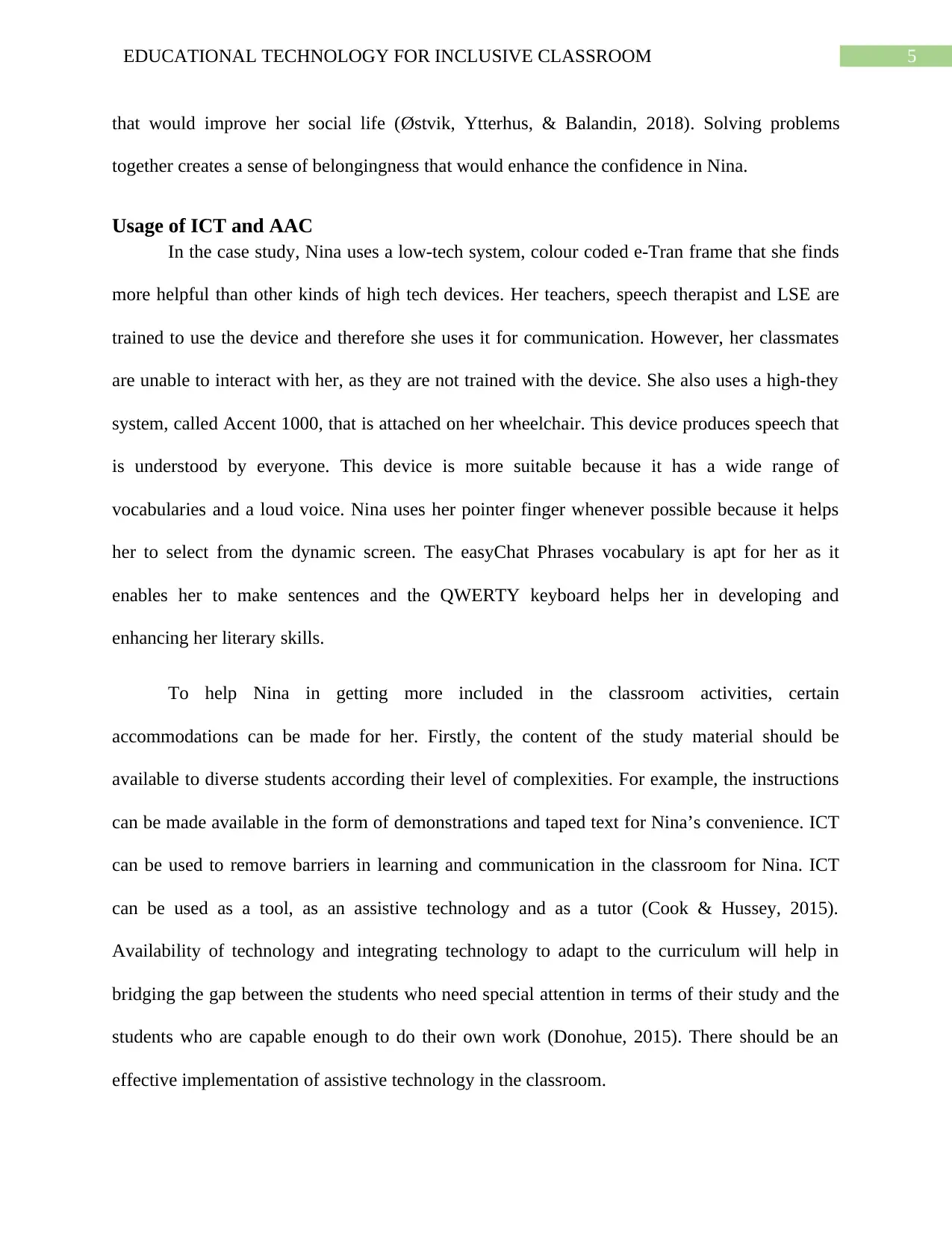
5EDUCATIONAL TECHNOLOGY FOR INCLUSIVE CLASSROOM
that would improve her social life (Østvik, Ytterhus, & Balandin, 2018). Solving problems
together creates a sense of belongingness that would enhance the confidence in Nina.
Usage of ICT and AAC
In the case study, Nina uses a low-tech system, colour coded e-Tran frame that she finds
more helpful than other kinds of high tech devices. Her teachers, speech therapist and LSE are
trained to use the device and therefore she uses it for communication. However, her classmates
are unable to interact with her, as they are not trained with the device. She also uses a high-they
system, called Accent 1000, that is attached on her wheelchair. This device produces speech that
is understood by everyone. This device is more suitable because it has a wide range of
vocabularies and a loud voice. Nina uses her pointer finger whenever possible because it helps
her to select from the dynamic screen. The easyChat Phrases vocabulary is apt for her as it
enables her to make sentences and the QWERTY keyboard helps her in developing and
enhancing her literary skills.
To help Nina in getting more included in the classroom activities, certain
accommodations can be made for her. Firstly, the content of the study material should be
available to diverse students according their level of complexities. For example, the instructions
can be made available in the form of demonstrations and taped text for Nina’s convenience. ICT
can be used to remove barriers in learning and communication in the classroom for Nina. ICT
can be used as a tool, as an assistive technology and as a tutor (Cook & Hussey, 2015).
Availability of technology and integrating technology to adapt to the curriculum will help in
bridging the gap between the students who need special attention in terms of their study and the
students who are capable enough to do their own work (Donohue, 2015). There should be an
effective implementation of assistive technology in the classroom.
that would improve her social life (Østvik, Ytterhus, & Balandin, 2018). Solving problems
together creates a sense of belongingness that would enhance the confidence in Nina.
Usage of ICT and AAC
In the case study, Nina uses a low-tech system, colour coded e-Tran frame that she finds
more helpful than other kinds of high tech devices. Her teachers, speech therapist and LSE are
trained to use the device and therefore she uses it for communication. However, her classmates
are unable to interact with her, as they are not trained with the device. She also uses a high-they
system, called Accent 1000, that is attached on her wheelchair. This device produces speech that
is understood by everyone. This device is more suitable because it has a wide range of
vocabularies and a loud voice. Nina uses her pointer finger whenever possible because it helps
her to select from the dynamic screen. The easyChat Phrases vocabulary is apt for her as it
enables her to make sentences and the QWERTY keyboard helps her in developing and
enhancing her literary skills.
To help Nina in getting more included in the classroom activities, certain
accommodations can be made for her. Firstly, the content of the study material should be
available to diverse students according their level of complexities. For example, the instructions
can be made available in the form of demonstrations and taped text for Nina’s convenience. ICT
can be used to remove barriers in learning and communication in the classroom for Nina. ICT
can be used as a tool, as an assistive technology and as a tutor (Cook & Hussey, 2015).
Availability of technology and integrating technology to adapt to the curriculum will help in
bridging the gap between the students who need special attention in terms of their study and the
students who are capable enough to do their own work (Donohue, 2015). There should be an
effective implementation of assistive technology in the classroom.
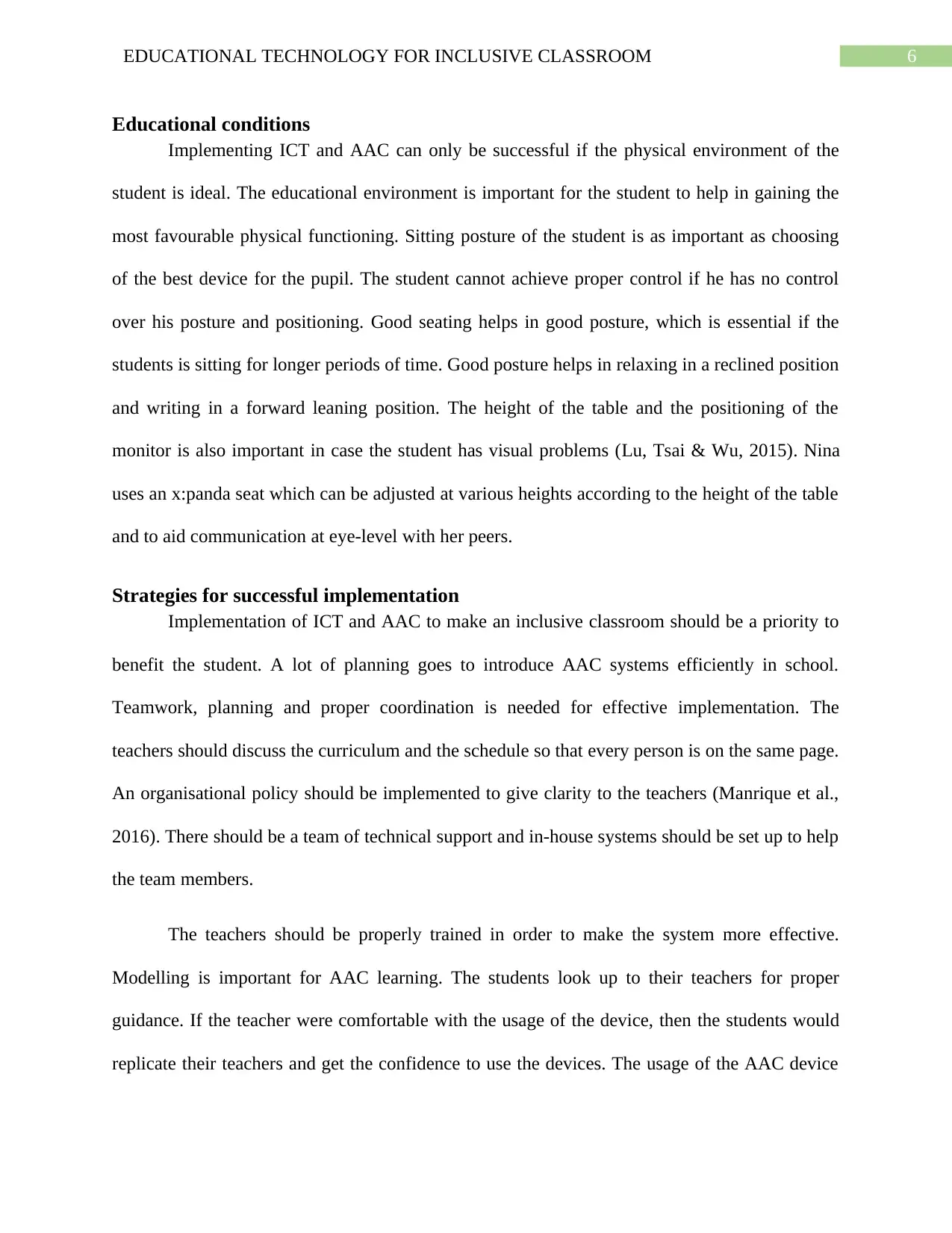
6EDUCATIONAL TECHNOLOGY FOR INCLUSIVE CLASSROOM
Educational conditions
Implementing ICT and AAC can only be successful if the physical environment of the
student is ideal. The educational environment is important for the student to help in gaining the
most favourable physical functioning. Sitting posture of the student is as important as choosing
of the best device for the pupil. The student cannot achieve proper control if he has no control
over his posture and positioning. Good seating helps in good posture, which is essential if the
students is sitting for longer periods of time. Good posture helps in relaxing in a reclined position
and writing in a forward leaning position. The height of the table and the positioning of the
monitor is also important in case the student has visual problems (Lu, Tsai & Wu, 2015). Nina
uses an x:panda seat which can be adjusted at various heights according to the height of the table
and to aid communication at eye-level with her peers.
Strategies for successful implementation
Implementation of ICT and AAC to make an inclusive classroom should be a priority to
benefit the student. A lot of planning goes to introduce AAC systems efficiently in school.
Teamwork, planning and proper coordination is needed for effective implementation. The
teachers should discuss the curriculum and the schedule so that every person is on the same page.
An organisational policy should be implemented to give clarity to the teachers (Manrique et al.,
2016). There should be a team of technical support and in-house systems should be set up to help
the team members.
The teachers should be properly trained in order to make the system more effective.
Modelling is important for AAC learning. The students look up to their teachers for proper
guidance. If the teacher were comfortable with the usage of the device, then the students would
replicate their teachers and get the confidence to use the devices. The usage of the AAC device
Educational conditions
Implementing ICT and AAC can only be successful if the physical environment of the
student is ideal. The educational environment is important for the student to help in gaining the
most favourable physical functioning. Sitting posture of the student is as important as choosing
of the best device for the pupil. The student cannot achieve proper control if he has no control
over his posture and positioning. Good seating helps in good posture, which is essential if the
students is sitting for longer periods of time. Good posture helps in relaxing in a reclined position
and writing in a forward leaning position. The height of the table and the positioning of the
monitor is also important in case the student has visual problems (Lu, Tsai & Wu, 2015). Nina
uses an x:panda seat which can be adjusted at various heights according to the height of the table
and to aid communication at eye-level with her peers.
Strategies for successful implementation
Implementation of ICT and AAC to make an inclusive classroom should be a priority to
benefit the student. A lot of planning goes to introduce AAC systems efficiently in school.
Teamwork, planning and proper coordination is needed for effective implementation. The
teachers should discuss the curriculum and the schedule so that every person is on the same page.
An organisational policy should be implemented to give clarity to the teachers (Manrique et al.,
2016). There should be a team of technical support and in-house systems should be set up to help
the team members.
The teachers should be properly trained in order to make the system more effective.
Modelling is important for AAC learning. The students look up to their teachers for proper
guidance. If the teacher were comfortable with the usage of the device, then the students would
replicate their teachers and get the confidence to use the devices. The usage of the AAC device
Paraphrase This Document
Need a fresh take? Get an instant paraphrase of this document with our AI Paraphraser
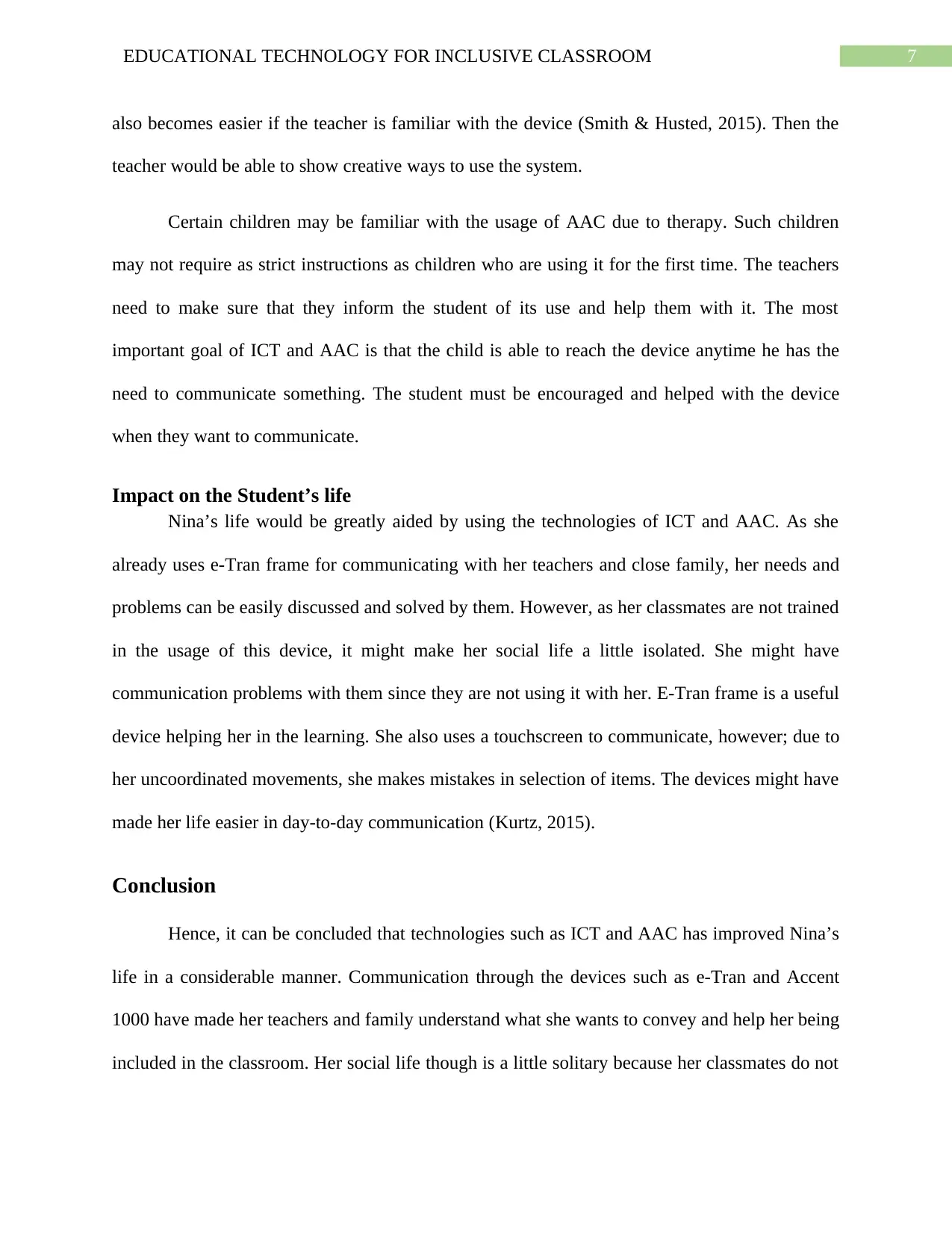
7EDUCATIONAL TECHNOLOGY FOR INCLUSIVE CLASSROOM
also becomes easier if the teacher is familiar with the device (Smith & Husted, 2015). Then the
teacher would be able to show creative ways to use the system.
Certain children may be familiar with the usage of AAC due to therapy. Such children
may not require as strict instructions as children who are using it for the first time. The teachers
need to make sure that they inform the student of its use and help them with it. The most
important goal of ICT and AAC is that the child is able to reach the device anytime he has the
need to communicate something. The student must be encouraged and helped with the device
when they want to communicate.
Impact on the Student’s life
Nina’s life would be greatly aided by using the technologies of ICT and AAC. As she
already uses e-Tran frame for communicating with her teachers and close family, her needs and
problems can be easily discussed and solved by them. However, as her classmates are not trained
in the usage of this device, it might make her social life a little isolated. She might have
communication problems with them since they are not using it with her. E-Tran frame is a useful
device helping her in the learning. She also uses a touchscreen to communicate, however; due to
her uncoordinated movements, she makes mistakes in selection of items. The devices might have
made her life easier in day-to-day communication (Kurtz, 2015).
Conclusion
Hence, it can be concluded that technologies such as ICT and AAC has improved Nina’s
life in a considerable manner. Communication through the devices such as e-Tran and Accent
1000 have made her teachers and family understand what she wants to convey and help her being
included in the classroom. Her social life though is a little solitary because her classmates do not
also becomes easier if the teacher is familiar with the device (Smith & Husted, 2015). Then the
teacher would be able to show creative ways to use the system.
Certain children may be familiar with the usage of AAC due to therapy. Such children
may not require as strict instructions as children who are using it for the first time. The teachers
need to make sure that they inform the student of its use and help them with it. The most
important goal of ICT and AAC is that the child is able to reach the device anytime he has the
need to communicate something. The student must be encouraged and helped with the device
when they want to communicate.
Impact on the Student’s life
Nina’s life would be greatly aided by using the technologies of ICT and AAC. As she
already uses e-Tran frame for communicating with her teachers and close family, her needs and
problems can be easily discussed and solved by them. However, as her classmates are not trained
in the usage of this device, it might make her social life a little isolated. She might have
communication problems with them since they are not using it with her. E-Tran frame is a useful
device helping her in the learning. She also uses a touchscreen to communicate, however; due to
her uncoordinated movements, she makes mistakes in selection of items. The devices might have
made her life easier in day-to-day communication (Kurtz, 2015).
Conclusion
Hence, it can be concluded that technologies such as ICT and AAC has improved Nina’s
life in a considerable manner. Communication through the devices such as e-Tran and Accent
1000 have made her teachers and family understand what she wants to convey and help her being
included in the classroom. Her social life though is a little solitary because her classmates do not
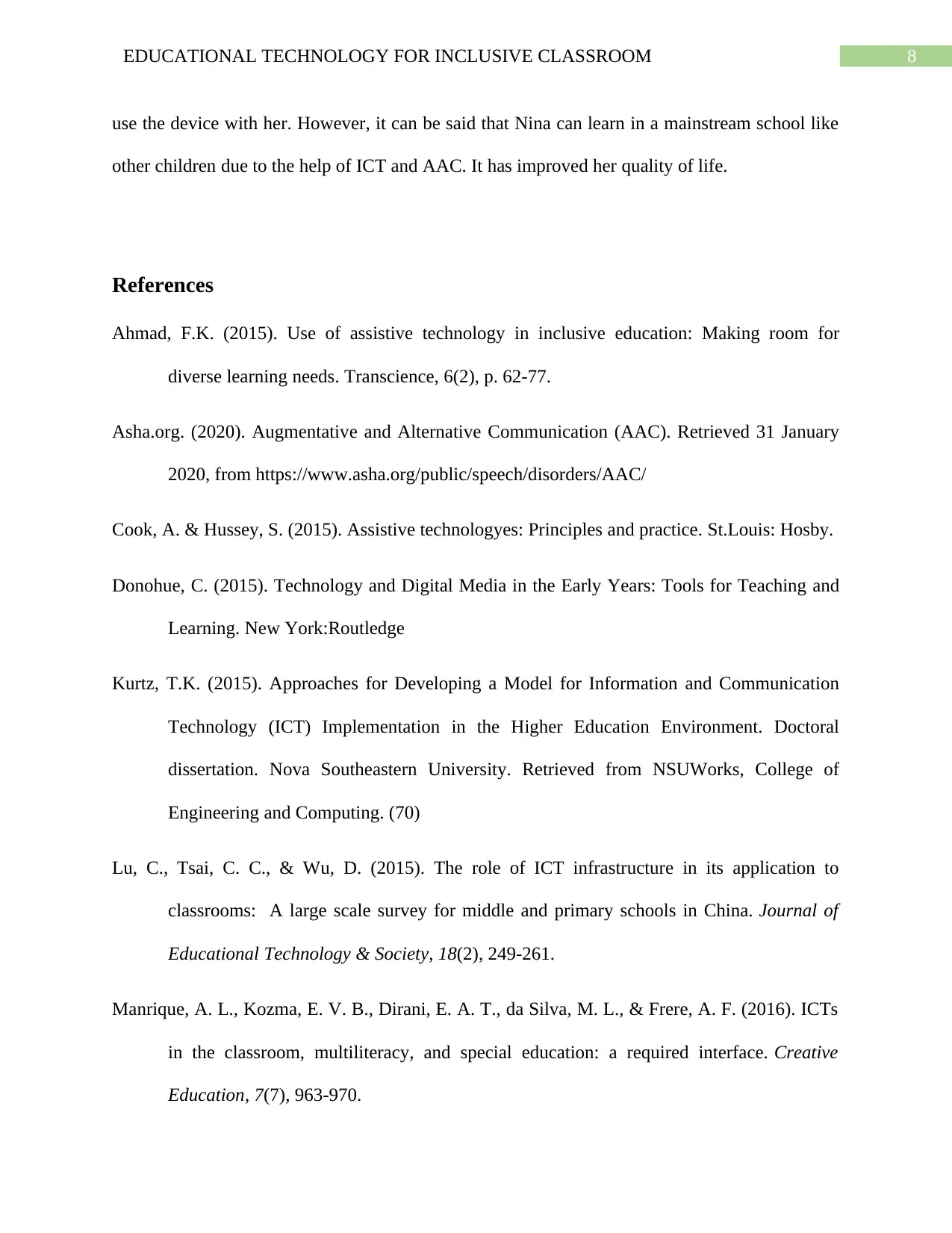
8EDUCATIONAL TECHNOLOGY FOR INCLUSIVE CLASSROOM
use the device with her. However, it can be said that Nina can learn in a mainstream school like
other children due to the help of ICT and AAC. It has improved her quality of life.
References
Ahmad, F.K. (2015). Use of assistive technology in inclusive education: Making room for
diverse learning needs. Transcience, 6(2), p. 62-77.
Asha.org. (2020). Augmentative and Alternative Communication (AAC). Retrieved 31 January
2020, from https://www.asha.org/public/speech/disorders/AAC/
Cook, A. & Hussey, S. (2015). Assistive technologyes: Principles and practice. St.Louis: Hosby.
Donohue, C. (2015). Technology and Digital Media in the Early Years: Tools for Teaching and
Learning. New York:Routledge
Kurtz, T.K. (2015). Approaches for Developing a Model for Information and Communication
Technology (ICT) Implementation in the Higher Education Environment. Doctoral
dissertation. Nova Southeastern University. Retrieved from NSUWorks, College of
Engineering and Computing. (70)
Lu, C., Tsai, C. C., & Wu, D. (2015). The role of ICT infrastructure in its application to
classrooms: A large scale survey for middle and primary schools in China. Journal of
Educational Technology & Society, 18(2), 249-261.
Manrique, A. L., Kozma, E. V. B., Dirani, E. A. T., da Silva, M. L., & Frere, A. F. (2016). ICTs
in the classroom, multiliteracy, and special education: a required interface. Creative
Education, 7(7), 963-970.
use the device with her. However, it can be said that Nina can learn in a mainstream school like
other children due to the help of ICT and AAC. It has improved her quality of life.
References
Ahmad, F.K. (2015). Use of assistive technology in inclusive education: Making room for
diverse learning needs. Transcience, 6(2), p. 62-77.
Asha.org. (2020). Augmentative and Alternative Communication (AAC). Retrieved 31 January
2020, from https://www.asha.org/public/speech/disorders/AAC/
Cook, A. & Hussey, S. (2015). Assistive technologyes: Principles and practice. St.Louis: Hosby.
Donohue, C. (2015). Technology and Digital Media in the Early Years: Tools for Teaching and
Learning. New York:Routledge
Kurtz, T.K. (2015). Approaches for Developing a Model for Information and Communication
Technology (ICT) Implementation in the Higher Education Environment. Doctoral
dissertation. Nova Southeastern University. Retrieved from NSUWorks, College of
Engineering and Computing. (70)
Lu, C., Tsai, C. C., & Wu, D. (2015). The role of ICT infrastructure in its application to
classrooms: A large scale survey for middle and primary schools in China. Journal of
Educational Technology & Society, 18(2), 249-261.
Manrique, A. L., Kozma, E. V. B., Dirani, E. A. T., da Silva, M. L., & Frere, A. F. (2016). ICTs
in the classroom, multiliteracy, and special education: a required interface. Creative
Education, 7(7), 963-970.
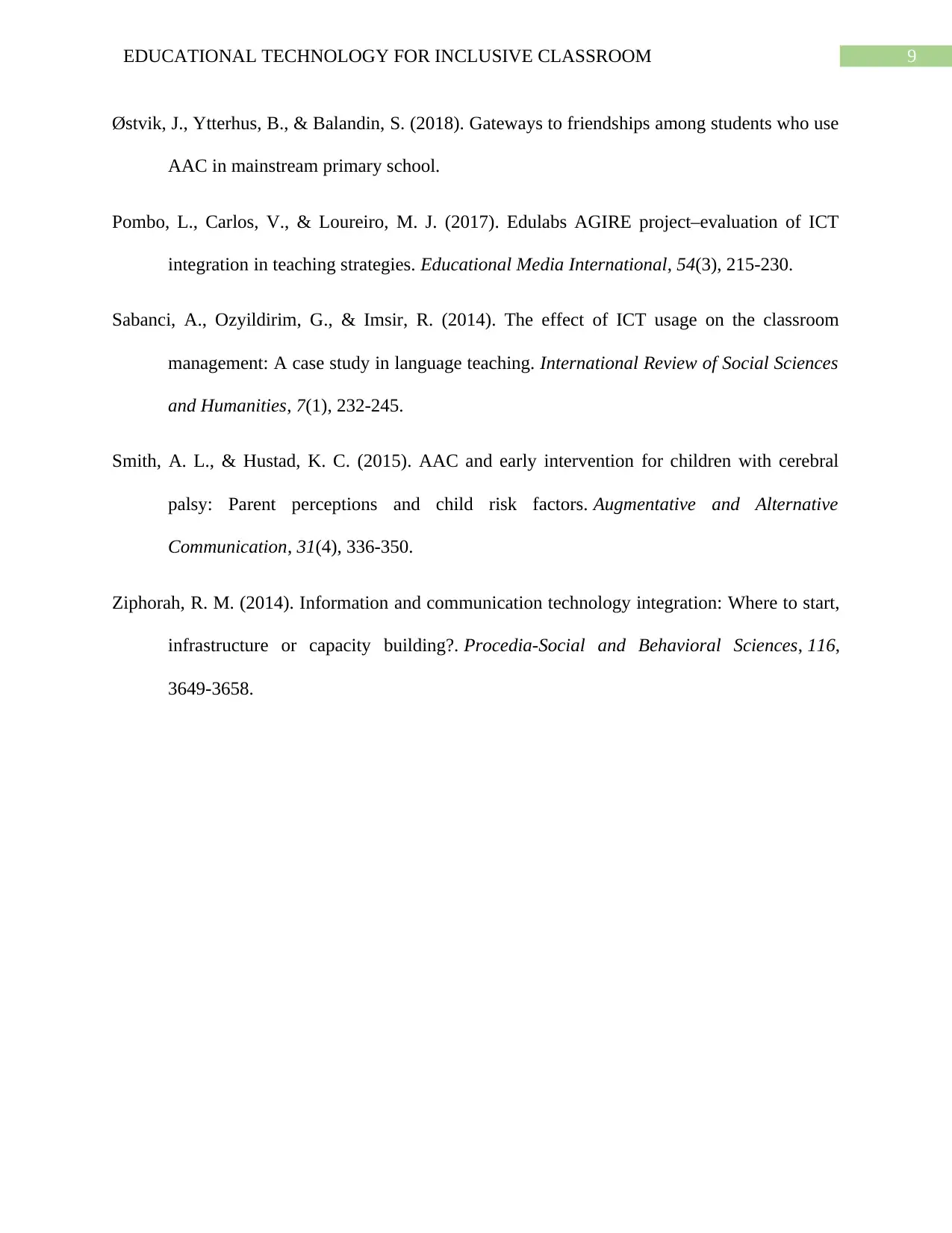
9EDUCATIONAL TECHNOLOGY FOR INCLUSIVE CLASSROOM
Østvik, J., Ytterhus, B., & Balandin, S. (2018). Gateways to friendships among students who use
AAC in mainstream primary school.
Pombo, L., Carlos, V., & Loureiro, M. J. (2017). Edulabs AGIRE project–evaluation of ICT
integration in teaching strategies. Educational Media International, 54(3), 215-230.
Sabanci, A., Ozyildirim, G., & Imsir, R. (2014). The effect of ICT usage on the classroom
management: A case study in language teaching. International Review of Social Sciences
and Humanities, 7(1), 232-245.
Smith, A. L., & Hustad, K. C. (2015). AAC and early intervention for children with cerebral
palsy: Parent perceptions and child risk factors. Augmentative and Alternative
Communication, 31(4), 336-350.
Ziphorah, R. M. (2014). Information and communication technology integration: Where to start,
infrastructure or capacity building?. Procedia-Social and Behavioral Sciences, 116,
3649-3658.
Østvik, J., Ytterhus, B., & Balandin, S. (2018). Gateways to friendships among students who use
AAC in mainstream primary school.
Pombo, L., Carlos, V., & Loureiro, M. J. (2017). Edulabs AGIRE project–evaluation of ICT
integration in teaching strategies. Educational Media International, 54(3), 215-230.
Sabanci, A., Ozyildirim, G., & Imsir, R. (2014). The effect of ICT usage on the classroom
management: A case study in language teaching. International Review of Social Sciences
and Humanities, 7(1), 232-245.
Smith, A. L., & Hustad, K. C. (2015). AAC and early intervention for children with cerebral
palsy: Parent perceptions and child risk factors. Augmentative and Alternative
Communication, 31(4), 336-350.
Ziphorah, R. M. (2014). Information and communication technology integration: Where to start,
infrastructure or capacity building?. Procedia-Social and Behavioral Sciences, 116,
3649-3658.
1 out of 10
Related Documents
Your All-in-One AI-Powered Toolkit for Academic Success.
+13062052269
info@desklib.com
Available 24*7 on WhatsApp / Email
![[object Object]](/_next/static/media/star-bottom.7253800d.svg)
Unlock your academic potential
© 2024 | Zucol Services PVT LTD | All rights reserved.





